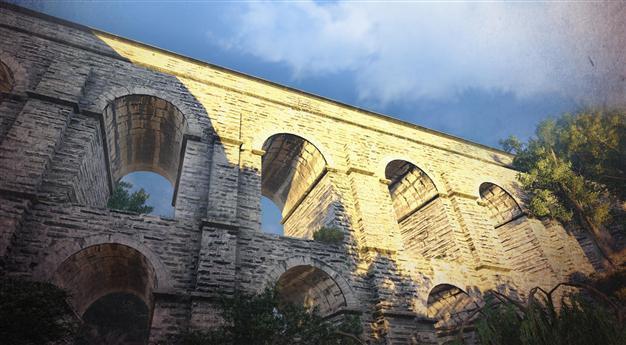History runs through ancient channels
Eren Güler ANKARA - Hürriyet Daily News

The exhibition reveals how archaeologists and scientists were able to map and document the water channels over a long period of time.
A new exhibition shines further light on the history of Istanbul, unraveling one of the biggest achievements in the history of Constantinople, the late Roman and Byzantine city.The long title of the exhibition is “Waters for a Capital: Archaeological and Scientific Research into the Water Supply of Byzantine Constantinople / Istanbul,” and it uncovers some of the greatest monuments, sharing the history of the Hagia Sophia, the relics of the Hippodrome, and the walls overlooking the Bosphorus.
The exhibition, which opened Nov. 9 at Koç University’s Research Center for Anatolian Civilizations (RCAC), reveals archaeological findings through photos and computer reconstructions of one of the longest and most extensive water channels ever constructed. Hidden in the dense forests of northern Thrace are the monuments to ancient water engineering, channeling and distributing water to Istanbul across hundreds of kilometers.
Turkish water engineers and remote-sensing experts have been working with British archaeologists for two decades to uncover the sources of water and the course of the channels. The exhibition reveals how archaeologists and scientists were able to map and document these monuments over a long period of time.
“Exploring the water supply monuments of the Constantinople was one the most exciting and intellectually satisfying projects of my archaeological career,” Jim Crow, a professor of classical archaeology at Edinburgh University, told the Hürriyet Daily News. Crow explains how the findings of vast relics, tunnels, channels and aqueducts in the hills of northern Thrace are a magnificent example of ancient water engineering, and one of the greatest engineering projects of any pre-modern society.
According to Crow, there are examples of Roman aqueducts all around the Mediterranean, a few of them being in Turkey. Then why are these ones any different? Crow cites two reasons. One, “the project is especially long, the individual channels are more than twice as long as any others,” totaling over 500 kilometers and “completed in a much shorter period of time, probably within a century.”
The second important point Crow gives is that “the late Roman and Byzantine periods are still often seen as periods of decline and decay. The evidence of the aqueducts provides clear, incontrovertible evidence for the ability of the late Roman state in its new capital on the Bosphorus to create a new dynamic city which continues to flourish today.”
Exhibiting the results of two projects
A series of studies have been undertaken in the area since the early 1990s by academics from Istanbul Technical University (İTÜ) and Edinburgh University. Professor Kazım Çeçen of İTÜ described and illustrated long-distance water channels and bridges for the first time in 1996. While Çeçen was the first to map the full line, Crow and his team were “able to document the structures in greater detail and provide a coherent historical context for the construction works from the fourth century to the 12th century.”
Around a decade later, the research was taken to another level. “Collaboration with Professor Derya Maktav of ITÜ from 2007 with the help of a grant from TÜBİTAK ensured that we were able to utilize his skills of remote sensing and to be able to use satellite images and a range of digital map sources,” said Crow. That’s why, says Crow, the “exhibition displays the results of the two projects.”
Crow also hinted at the possibilities of “sustainable tourism” in the area. “There is a huge potential to develop the visitor potential of this region. I have taken specialist tours and visitors are astonished by the scale of the monuments,” he said.
“Any development needs to consider the economic and natural heritage of the region, but these monuments are world class in their significance and demand to be better recognized and presented.
Any increase in tourism needs to recognize the conservation and preservation needs of both the great monuments and the complex network of tunnels,” he said.
Is the research in the area over then? “Currently, we have completed our fieldwork although we are still writing articles and are developing new ways to investigate the extensive body of data we have already assembled,” said Crow, who is currently completing his publication of the Anastasian Wall project in the same region, adding that he hoped to be able to prepare an updated edition of a monograph on the water supply in English published in 2008.
The exhibition can be seen until early 2013 at RCAC. The center was established earlier this year to support and disseminate research on Turkey’s history, increase the quality and quantity of research on the archaeology of Turkey, museum studies and heritage management, and also to increase the awareness of the contributions and interactions Anatolian civilizations have had with other major world civilizations.
















